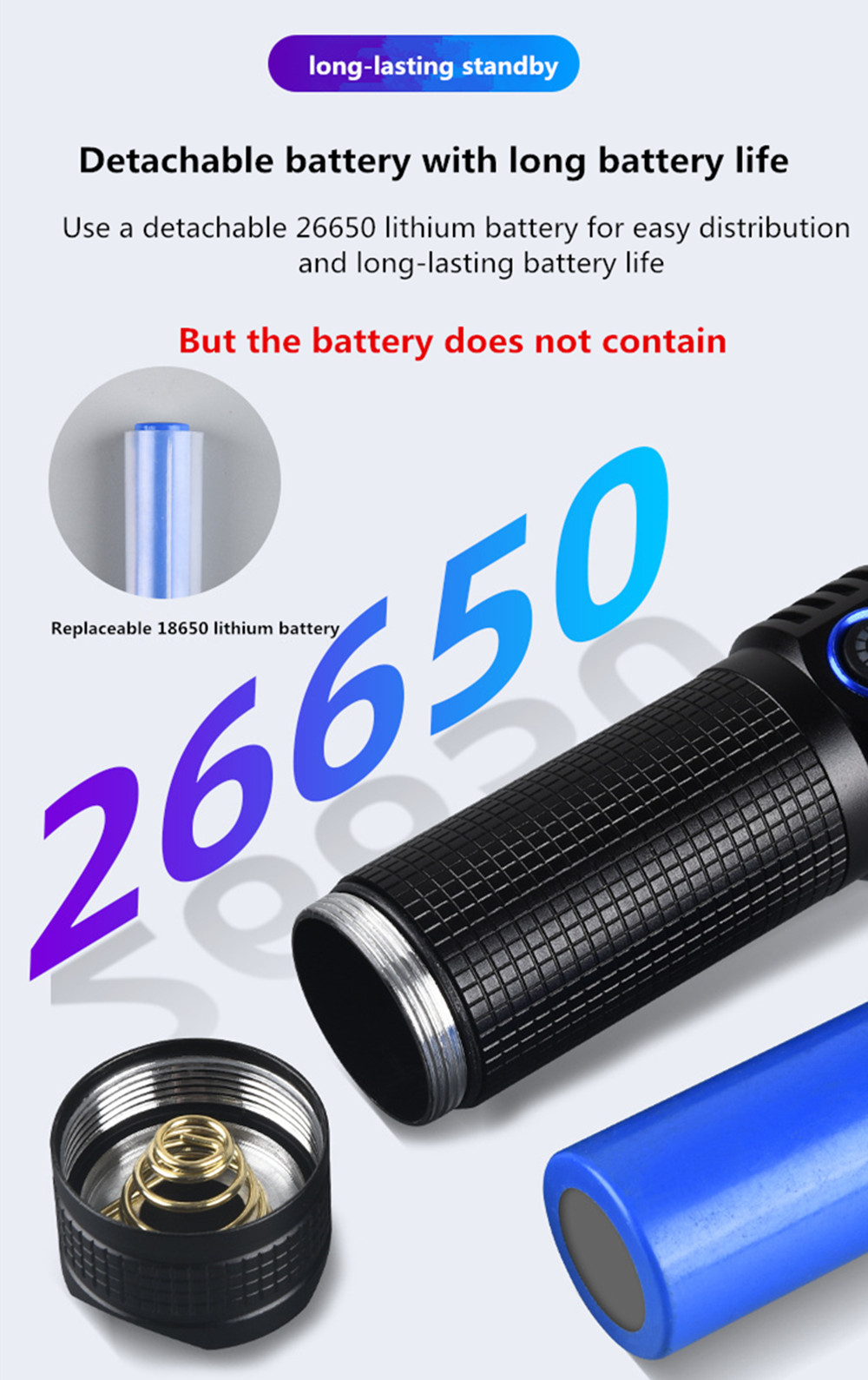Why Rechargeable Flashlights are Perfect for Regular Use

Rechargeable flashlights offer you a cost-effective and eco-friendly solution for daily use. They eliminate the need for disposable batteries, saving you money over time. For instance, businesses using 100 flashlights can save over $200 per unit annually. With rechargeable options, you also enjoy consistent performance and the convenience of USB charging.
Key Takeaways
Rechargeable flashlights help save money by not needing throwaway batteries. You can save up to $200 each year per flashlight, which makes them a good choice.
Using rechargeable flashlights cuts down on trash. They work longer and reduce harmful battery waste, helping the environment.
Check important features when picking a rechargeable flashlight. Think about brightness, strength, battery life, and how it charges to choose the right one for you.
Cost-Effectiveness of Rechargeable Flashlights
Long-Term Savings
When you consider the long-term costs of lighting solutions, rechargeable flashlights stand out as a smart investment. While they may have a higher upfront cost compared to traditional flashlights, their ability to be recharged hundreds of times eliminates the need for constant battery replacements. This feature alone can save you significant money over time. For example, businesses using 100 flashlights can save over $200 per flashlight in the first year by switching to rechargeable options.
The savings extend beyond just businesses. For individual users, the cost of disposable alkaline batteries can add up quickly. On average, you might spend $48 annually on disposable batteries. In contrast, a four-pack of rechargeable batteries costs around $30 and can last for years. After just eight months, you break even, and by the end of the first year, you save $48. Over the lifespan of rechargeable batteries, your total savings could reach nearly $950.
No Need for Disposable Batteries
One of the most significant advantages of buying rechargeable flashlights is the elimination of disposable batteries. Traditional flashlights rely on alkaline or lithium batteries, which often need frequent replacements. Rechargeable flashlights, however, come equipped with built-in rechargeable batteries or use external ones that can be reused multiple times.
To illustrate the difference, consider the lifespan of rechargeable batteries versus disposable ones. Rechargeable batteries can last up to 500 uses, while disposable batteries typically last only 3 to 14 days, depending on usage. This longevity not only saves you money but also reduces the hassle of constantly purchasing and replacing batteries.
By choosing rechargeable flashlights, you make a cost-effective decision that benefits both your wallet and your convenience.
Environmental Benefits of Rechargeable Flashlights

Reducing Battery Waste
Switching to rechargeable flashlights significantly reduces the amount of battery waste generated each year. Disposable batteries contribute to environmental pollution by releasing harmful chemicals like lead, mercury, and cadmium when improperly discarded. These substances can seep into soil and water, damaging ecosystems and endangering human health. Rechargeable batteries, on the other hand, minimize this impact by lasting longer and requiring fewer replacements.
Consider the example of a heavy equipment manufacturer. Before adopting rechargeable flashlights, the company used approximately 16,000 replacement batteries annually. By making the switch, they not only reduced battery waste but also saved over $200 per flashlight in the first year. This demonstrates how rechargeable solutions can create a more sustainable workplace while cutting costs.
Supporting Sustainability
Rechargeable flashlights are better for the environment because they align with global efforts to reduce waste and promote eco-friendly practices. The growing popularity of rechargeable LED flashlights highlights this trend. These devices are energy-efficient and have a longer lifespan compared to traditional flashlights, making them a preferred choice for sustainability-conscious consumers.
Rechargeable batteries lower recycling costs for manufacturers.
They decrease the waste generated from single-use batteries.
This transition helps businesses achieve greener operations.
By choosing rechargeable options, you contribute to a cleaner planet and support sustainability initiatives. The shift to rechargeable flashlights reflects a broader commitment to reducing environmental impact and embracing responsible consumption.
Performance and Convenience

Consistent Light Output
Rechargeable flashlights deliver a superior lighting experience compared to traditional options. They often utilize advanced LED technology, which ensures brighter and more consistent illumination. Unlike traditional flashlights that dim as their batteries deplete, rechargeable models maintain steady brightness throughout their charge cycle. This reliability makes them ideal for tasks requiring dependable light, such as camping, hiking, or emergency repairs.
The consistent light output of rechargeable flashlights also enhances safety and efficiency. Whether you are navigating dark trails or working in low-light conditions, you can trust these flashlights to provide uninterrupted illumination. Their ability to sustain brightness for longer durations ensures you won’t be left in the dark when you need light the most.
Advantages of a USB Rechargeable Flashlight
A USB rechargeable flashlight offers unmatched convenience and versatility. You can charge it using any USB-compatible power source, such as a laptop, power bank, or car charger. This eliminates the need for disposable batteries, saving you money and reducing environmental waste.
USB rechargeable flashlights are also durable and reliable, making them perfect for everyday carry, outdoor adventures, and emergency preparedness. Many models, including USB-C rechargeable flashlights, feature faster charging times and longer runtimes, ensuring they are ready whenever you need them. Their eco-friendly design aligns with sustainable practices, while their cost-effectiveness makes them a practical choice for regular use.
By choosing a USB rechargeable flashlight, you gain a dependable tool that combines performance, convenience, and environmental responsibility.
How to Find the Right Rechargeable Flashlight
Key Features to Consider
When you set out to find the right rechargeable flashlight, focus on features that match your needs. Brightness is a critical factor. Look for models with adjustable settings and higher lumens for better visibility. A flashlight with multiple modes, such as strobe or SOS, can enhance usability in different scenarios.
Durability is another essential feature. Choose a flashlight that can withstand wear and tear, especially if you plan to use it outdoors. Water resistance is also crucial for handling unexpected weather conditions. Additionally, consider the weight and size. A lightweight and compact flashlight is easier to carry, making it ideal for everyday use or outdoor adventures.
Battery type and charging options play a significant role in convenience. Flashlights with lithium-ion batteries offer long battery runtime and better efficiency. Opt for models with USB-C or Micro-USB charging ports for faster and more accessible charging. Lastly, evaluate the warranty and price. A good warranty ensures coverage for defects, while focusing on quality over cost guarantees better performance.
Battery Capacity and Runtime
Battery capacity directly impacts the runtime of a rechargeable flashlight. Higher-capacity batteries allow the flashlight to operate for longer durations before needing a recharge. This feature is especially important for tasks requiring extended use, such as camping or emergency situations.
Energy efficiency also affects runtime. Flashlights with advanced LED technology minimize discharge rates, ensuring consistent performance. Lithium-ion batteries are a preferred choice due to their ability to store more energy and deliver longer runtimes. When selecting a flashlight, always check the battery capacity to ensure it meets your usage requirements.
By considering these factors, you can confidently choose a rechargeable flashlight that combines performance, durability, and convenience.
Rechargeable flashlights offer long-term benefits that make them ideal for regular use. They save you money by eliminating disposable batteries and reduce environmental waste. Advanced features, like hands-free lighting and adjustable modes, enhance usability. Switching to a rechargeable flashlight ensures superior performance, convenience, and sustainability, making it a smart choice for everyday tasks and emergencies.
FAQ
What makes rechargeable flashlights better than traditional ones?
Rechargeable flashlights offer cost savings, eco-friendliness, and consistent performance. They eliminate disposable batteries, provide longer runtimes, and feature convenient charging options like USB compatibility.
How long do rechargeable flashlight batteries last?
Rechargeable batteries typically last 500 to 1,000 charge cycles. Their lifespan depends on usage and maintenance. Proper care ensures years of reliable performance.
Can I use a rechargeable flashlight in extreme conditions?
Yes, many rechargeable flashlights are designed for durability. Look for models with water resistance, impact resistance, and temperature tolerance to handle harsh environments effectively.
💡 Tip: Always check the flashlight’s specifications to ensure it meets your specific needs for outdoor or emergency use.
See Also
How Rechargeable Flashlights Enhance Community Safety Measures
Selecting The Ideal Rechargeable Flashlight For Outdoor Adventures
Discover Your Ideal Flashlight For Daily Use
Comparing Police Flashlights And Standard Flashlights: A Guide
